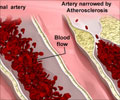Standards for the use of ultrasound as a screening tool to measure narrowing of the carotid artery may be too aggressive
Standards for the use of ultrasound as a screening tool to measure narrowing of the carotid artery may be too aggressive, resulting in some needless follow-up tests and procedures according to researchers at the University of Chicago Medical Center. Narrowing of the carotid can be a precursor to a stroke.
Hisham Bassiouny, MD, director of the non-invasive vascular lab and interim section chief of vascular surgery at the University of Chicago, presented the findings of a study today at the Society for Vascular Surgery’s Annual Meeting in Baltimore.These standards, used by the majority of vascular laboratories around the country since the early 1980s, were based on the use of angiography, a medical imaging technique in which an X-ray picture is taken to visualize the inner opening of blood filled structures.
“The limitation with angiography is that you had to guess how far the outer wall of the artery was beyond the artery’s channel to determine the precise degree of artery blockage,” he says. “That was a guess, an estimate. Based upon that subjective estimate, formulas were developed to look at the velocity of blood flow in the artery and determine how much narrowing existed. These formulas became the standard used to this day. However, imaging technology is much better today than when these standards were developed.”
The researchers studied 74 patients with narrowing of the carotid arteries. They used ultrasound to assess the narrowing and compared the results from ultrasound to those found using CT angiography. Both techniques produced similar results, with nearly identical measures of the size of the channel inside the artery.
Further study of another 337 mild, moderate, and severely narrowed arteries, using high-resolution ultrasound techniques, looked at the diameter of the outer wall of the arteries. Standards were developed according to each individualized measurement. The results using the new standards indicated that blood flow was often better than the old standards would predict.
Previously, the researchers found that a peak systolic blood velocity of 125 centimeters per second indicated the artery was narrowed by at least 50 percent. Now, they think a peak systolic blood velocity of 155 centimeters per second indicates a 50 percent narrowing.
Advertisement
Source-Eurekalert
MED






